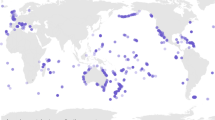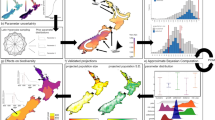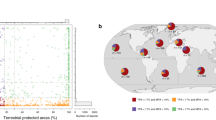Abstract
The discovery and colonization of islands by humans has invariably resulted in their widespread ecological transformation. The small and isolated populations of many island taxa, and their evolution in the absence of humans and their introduced taxa, mean that they are particularly vulnerable to human activities. Consequently, even the most degraded islands are a focus for restoration, eradication, and monitoring programmes to protect the remaining endemic and/or relict populations. Here, we build a framework that incorporates an assessment of the degree of change from multiple baseline reference periods using long-term ecological data. The use of multiple reference points may provide information on both the variability of natural systems and responses to successive waves of cultural transformation of island ecosystems, involving, for example, the alteration of fire and grazing regimes and the introduction of non-native species. We provide exemplification of how such approaches can provide valuable information for biodiversity conservation managers of island ecosystems.
This is a preview of subscription content, access via your institution
Access options
Access Nature and 54 other Nature Portfolio journals
Get Nature+, our best-value online-access subscription
$29.99 / 30 days
cancel any time
Subscribe to this journal
Receive 12 digital issues and online access to articles
$119.00 per year
only $9.92 per issue
Buy this article
- Purchase on Springer Link
- Instant access to full article PDF
Prices may be subject to local taxes which are calculated during checkout




Similar content being viewed by others
References
Caujapé-Castells, J. et al. Conservation of oceanic island floras: Present and future global challenges. Persp. Plant Ecol. Evol. System. 12, 107–129 (2010).
Vitousek, P. M. Oceanic islands as model systems for ecological studies. J. Biogeogr. 29, 573–582 (2002).
Kaiser-Bunbury, C. N., Traveset, A. & Hansen, D. M. Conservation and restoration of plant–animal mutualisms on oceanic islands. Persp. Plant Ecol. Evol. System. 12, 131–143 (2010).
Kueffer, C. et al. A global comparison of plant invasions on oceanic islands. Persp. Plant Ecol. Evol. System. 12, 145–161 (2010).
Jones, H. P. et al. Invasive mammal eradication on islands results in substantial conservation gains. Proc. Natl Acad. Sci. USA 113, 4033–4038 (2016).
Avery, J. D., Fonseca, D. M., Campagne, P. & Lockwood, J. L. Cryptic introductions and the interpretation of island biodiversity. Mol. Ecol. 22, 2313–2324 (2013).
Whittaker R. J. & Fernández-Palacios J. M. Island Biogeography: Ecology, Evolution, and Conservation. (Oxford Univ. Press, 2007).
Jackson, S. T. & Hobbs, R. J. Ecological restoration in the light of ecological history. Science 325, 567–569 (2009).
Bellingham, B. J. et al. New Zealand island restoration: seabirds, predators, and the importance of history. New Zeal. J. Ecol. 34, 115–136 (2010).
Lyver, P. O. B. et al. Looking back for the future: local knowledge and palaeoecology inform biocultural restoration of coastal ecosystems in New Zealand. Hum. Ecol. 43, 681–695 (2015).
Burney, D. A. Tropical islands as paleoecological laboratories: gauging the consequences of human arrival. Hum. Ecol. 25, 437–457 (1997).
Hobbs, R. J., Higgs, E. & Harris, J. A. Novel ecosystems: implications for conservation and restoration. Trends Ecol. Evol. 24, 599–605 (2009).
Dietl, G. P. et al. Conservation paleobiology: leveraging knowledge of the past to inform conservation and restoration. Annu. Rev. Earth Planet. Sci. 43, 79 (2015).
Gillson, L., Ladle, R. J. & Araújo, M. B. in Conservation Biogeography 31–44 (John Wiley & Sons, 2011).
Willis, K. J., Bailey, R. M., Bhagwat, S. A. & Birks, H. J. B. Biodiversity baselines, thresholds and resilience: testing predictions and assumptions using palaeoecological data. Trends Ecol. Evol. 25, 583–591 (2010).
Wilmshurst, J. M. et al. Use of pollen and ancient DNA as conservation baselines for offshore islands in New Zealand. Conserv. Biol. 28, 202–212 (2014).
Froyd, C. A. et al. The ecological consequences of megafaunal loss: giant tortoises and wetland biodiversity. Ecol. Lett. 17, 144–154 (2014).
Wood, J. R., Wilmshurst, J. M., Worthy, T. H. & Cooper, A. Sporormiella as a proxy for non-mammalian herbivores in island ecosystems. Quat. Sci. Rev. 30, 915–920 (2011).
Burney, D. A. & Burney, L. P. Paleoecology and “inter-situ” restoration on Kaua’i, Hawai’i. Front. Ecol. Environ. 5, 483–490 (2007).
Callicott, J. B. The pragmatic power and promise of theoretical environmental ethics: forging a new discourse. Environ. Values 11, 3–25 (2002).
van Leeuwen, J. F. N. et al. Fossil pollen as a guide to conservation in the Galápagos. Science 322, 1206–1206 (2008).
Delisle, F., Lavoie, C., Jean, M. & Lachance, D. Reconstructing the spread of invasive plants: taking into account biases associated with herbarium specimens. J. Biogeogr. 30, 1033–1042 (2003).
Cañellas-Boltà, N., Rull, V., Sáez, A., Prebble, M. & Margalef, O. First records and potential palaeoecological significance of Dianella (Xanthorrhoeaceae), an extinct representative of the native flora of Rapa Nui (Easter Island). Veg. Hist. Archaeobot. 23, 331–338 (2014).
Froyd, C. A. & Willis, K. J. Emerging issues in biodiversity & conservation management: the need for a palaeoecological perspective. Quat. Sci. Rev. 27, 1723–1732 (2008).
Willis, K. J. et al. How can a knowledge of the past help to conserve the future? Biodiversity conservation and the relevance of long-term ecological studies. Philos. Trans. R. Soc. Lon. B 362, 175–187 (2007).
Bean, A. R. A new system for determining which plant species are indigenous in Australia. Aust. Syst. Bot. 20, 1–43 (2007).
Carlton, J. T. Biological invasions and cryptogenic species. Ecology 77, 1653–1655 (1996).
Wilmshurst, J. M., McGlone, M. S. & Turney, C. S. M. Long-term ecology resolves the timing, region of origin and process of establishment for a disputed alien tree. AoB Plants 7, plv104 (2015).
Benning, T. L., LaPointe, D., Atkinson, C. T. & Vitousek, P. M. Interactions of climate change with biological invasions and land use in the Hawaiian Islands: modeling the fate of endemic birds using a geographic information system. Proc. Natl Acad. Sci. USA 99, 14246–14249 (2002).
Coffey, E. E. D., Froyd, C. A. & Willis, K. J. When is an invasive not an invasive? Macrofossil evidence of doubtful native plant species in the Galápagos Islands. Ecology 92, 805–812 (2011).
de Boer, E. J. et al. Multi-proxy reconstruction of environmental dynamics and colonization impacts in the Mauritian uplands. Palaeogeogr. Palaeoclim. Palaeoecol. 383–384, 42–51 (2013).
de Nascimento, L., Willis, K. J., Fernández-Palacios, J. M., Criado, C. & Whittaker, R. J. The long-term ecology of the lost forests of La Laguna, Tenerife (Canary Islands). J. Biogeogr. 36, 499–514 (2009).
van Leeuwen, J. F. et al. Native or introduced? Fossil pollen and spores may say. An example from the Azores Islands. Neobiota 6, 27–34 (2005).
Evans, J. Pistia stratiotes L. in the Florida Peninsula: biogeographic evidence and conservation implications of native tenure for an ‘invasive’ aquatic plant. Conserv. Soc. 11, 233–246 (2013).
Rosati, L., Masi, A., Giardini, M. & Marignani, M. Under the shadow of a big plane tree: Why Platanus orientalis should be considered an archaeophyte in Italy. Plant Biosyst. 149, 185–194 (2015).
Agudo, R., Rico, C., Vilà, C., Hiraldo, F. & Donázar, J. A. The role of humans in the diversification of a threatened island raptor. BMC Evol. Biol. 10, 384 (2010).
Roebroeks, W. & Villa, P. On the earliest evidence for habitual use of fire in Europe. Proc. Natl Acad. Sci. USA 108, 5209–5214 (2011).
Rolett, B. & Diamond, J. Environmental predictors of pre-European deforestation on Pacific islands. Nature 431, 443–446 (2004).
Conedera, M. et al. Reconstructing past fire regimes: methods, applications, and relevance to fire management and conservation. Quat. Sci. Rev. 28, 555–576 (2009).
Scott, A. C., Hardiman, M., Pinter, N. & Anderson, R. S. Evidence of fire regimes in the Pleistocene of the California Islands. SAGVNTVM Extra 11, 59–60 (2011).
Iglesias, V., Yospin, G. I. & Whitlock, C. Reconstruction of fire regimes through integrated paleoecological proxy data and ecological modeling. Front. Plant Sci. 5, 785 (2015).
Gil-Romera, G. et al. Biomass-modulated fire dynamics during the Last Glacial–Interglacial Transition at the Central Pyrenees (Spain). Palaeogeogr. Palaeoclim. Palaeoecol. 402, 113–124 (2014).
Perry, G. L. W., Wilmshurst, J. M., Ogden, J. & Enright, N. J. Exotic mammals and invasive plants alter fire-related thresholds in southern temperate forested landscapes. Ecosystems 18, 1290–1305 (2015).
Brooks, M. L. et al. Effects of invasive alien plants on fire regimes. BioScience 54, 677–688 (2004).
McWethy, D. B. et al. Rapid landscape transformation in South Island, New Zealand, following initial Polynesian settlement. Proc. Natl Acad. Sci. USA 107, 21343–21348 (2010).
McWethy, D. B., Wilmshurst, J. M., Whitlock, C., Wood, J. R. & McGlone, M. S. A high-resolution chronology of rapid forest transitions following Polynesian arrival in New Zealand. PLoS ONE 9, e111328 (2014).
Perry, G. L. W., Wilmshurst, J. M., McGlone, M. S. & Napier, A. Reconstructing spatial vulnerability to forest loss by fire in pre-historic New Zealand. Glob. Ecol. Biogeogr. 21, 1029–1041 (2012).
Higuera-Gundy, A. et al. A 10,300 14C yr record of climate and vegetation change from Haiti. Quat. Res. 52, 159–170 (1999).
Leys, B., Finsinger, W. & Carcaillet, C. Historical range of fire frequency is not the Achilles’ heel of the Corsican black pine ecosystem. J. Ecol. 102, 381–395 (2014).
Garzón-Machado, V., del-Arco-Aguilar, M. J. & Pérez-de-Paz, P. L. Threat or threatened species? A paradox in conservation biology. J. Nat. Conserv. 20, 228–230 (2012).
Bowen, L. & Vuren, D. V. Insular endemic plants lack defenses against herbivores. Conserv. Biol. 11, 1249–1254 (1997).
Fraser, I. & Chisholm, T. Conservation or cultural heritage? Cattle grazing in the Victoria Alpine National Park. Ecol. Econ. 33, 63–75 (2000).
Campbell, K. & Donlan, C. J. Feral goat eradications on Islands. Conserv. Biol. 19, 1362–1374 (2005).
Garzón-Machado, V. et al. Strong negative effect of alien herbivores on endemic legumes of the Canary pine forest. Biol. Conserv. 143, 2685–2694 (2010).
Peco, B., Sánchez, A. M. & Azcárate, F. M. Abandonment in grazing systems: consequences for vegetation and soil. Agr. Ecosyst. Environ. 113, 284–294 (2006).
Burney, D. A., Robinson, G. S. & Burney, L. P. Sporormiella and the late Holocene extinctions in Madagascar. Proc. Natl Acad. Sci. USA 100, 10800–10805 (2003).
Gill, J. L., Williams, J. W., Jackson, S. T., Lininger, K. B. & Robinson, G. S. Pleistocene megafaunal collapse, novel plant communities, and enhanced fire regimes in North America. Science 326, 1100–1103 (2009).
Hansen, D. M. Non-native megaherbivores: the case for novel function to manage plant invasions on islands. AoB Plants 7, plv085 (2015).
Chapuis, J. L. et al. Eradication of invasive herbivores: usefulness and limits for biological conservation in a changing world. Anim. Conserv. 14, 471–473 (2011).
Schweizer, D., Jones, H. P. & Holmes, N. D. Literature review and meta-analysis of vegetation responses to goat and European rabbit eradications on islands. Pacific Sci. 70, 55–71 (2015).
Innes, J. et al. Effect of grazing on ship rat density in forest fragments of lowland Waikato, New Zealand. New Zeal. J. Ecol. 34, 227–232 (2010).
Veitch, C.R & Clout, M. N. (eds) Turning the Tide: The Eradication of Invasive Species (IUCN, 2002).
Bergstrom, D. M. et al. Indirect effects of invasive species removal devastate World Heritage Island. J. Appl. Ecol. 46, 73–81 (2009).
Hansen, D. M., Donlan, C. J., Griffiths, C. J. & Campbell, K. J. Ecological history and latent conservation potential: large and giant tortoises as a model for taxon substitutions. Ecography 33, 272–284 (2010).
Wood, J. R., Wilmshurst, J. M., Turney, C. S. M. & Fogwill, C. J. Palaeoecological signatures of vegetation change induced by herbivory regime shifts on subantarctic Enderby Island. Quat. Sci. Rev. 134, 51–58 (2016).
Baker, A. G., Bhagwat, S. A. & Willis, K. J. Do dung fungal spores make a good proxy for past distribution of large herbivores? Quat. Sci. Rev. 62, 21–31 (2013).
Davis, O. K. Spores of the dung fungus Sporormiella: increased abundance in historic sediments and before Pleistocene megafaunal extinction. Quat. Res. 28, 290–294 (1987).
Gill, J. L. et al. Linking abundances of the dung fungus Sporormiella to the density of bison: implications for assessing grazing by megaherbivores in palaeorecords. J. Ecol. 101, 1125–1136 (2013).
Raczka, M. F., Bush, M. B., Folcik, A. M. & McMichael, C. H. Sporormiella as a tool for detecting the presence of large herbivores in the Neotropics. Biota Neotropica 16, e20150090 (2016).
Athens, J. S. Rattus exulans and the catastrophic disappearance of Hawai’i's native lowland forest. Biol. Invasions 11, 1489 (2008).
Illera, J. C., Rando, J. C., Richardson, D. S. & Emerson, B. C. Age, origins and extinctions of the avifauna of Macaronesia: a synthesis of phylogenetic and fossil information. Quat. Sci. Rev. 50, 14–22 (2012).
Steadman, D. W. Extinction and Biogeography of Tropical Pacific Birds (Univ. Chicago Press, 2006).
Taylor, R. H. How the Macquaire island parakeet became extinct. New Zeal. J. Ecol. 2, 42–45 (1979).
Lomolino, M. V. et al. Of mice and mammoths: generality and antiquity of the island rule. J. Biogeography 40, 1427–1439 (2013).
Rijsdijk, K. F. et al. A review of the dodo and its ecosystem: insights from a vertebrate concentration Lagerstätte in Mauritius. J. Vert. Paleontol. 35, 3–20 (2015).
de Boer, E. J. et al. A deadly cocktail: how a drought around 4200 cal. yr BP caused mass mortality events at the infamous ‘dodo swamp’ in Mauritius. Holocene 25, 758–771 (2015).
Graham, R. W. et al. Timing and causes of mid-Holocene mammoth extinction on St. Paul Island, Alaska. Proc. Natl Acad. Sci. USA 113, 9310–9314 (2016).
Wilmshurst, J. M., McGlone, M. S. & Partridge, T. R. A late Holocene history of natural disturbance in lowland podocarp/hardwood forest, Hawke's Bay, New Zealand. New Zeal. J. Bot. 35, 79–96 (1997).
Wilmshurst, J. M., McGlone, M. S., Leathwick, J. R. & Newnham, R. M. A pre-deforestation pollen-climate calibration model for New Zealand and quantitative temperature reconstructions for the past 18 000 years BP. J. Quat. Sci. 22, 535–547 (2007).
Haberle, S. G. Late Quaternary vegetation dynamics and human impact on Alexander Selkirk Island, Chile. J. Biogeogr. 30, 239–255 (2003).
Gillson, L. & Marchant, R. From myopia to clarity: sharpening the focus of ecosystem management through the lens of palaeoecology. Trends Ecol. Evol. 29, 317–325 (2014).
McCarroll, J., Chambers, F. M., Webb, J. C. & Thom, T. Using palaeoecology to advise peatland conservation: An example from West Arkengarthdale, Yorkshire, UK. J. Nat. Conserv. 30, 90–102 (2016).
Barnosky, A. D. et al. Merging paleobiology with conservation biology to guide the future of terrestrial ecosystems. Science http://doi.org/10.1126/science.aah4787 (2017).
Acknowledgements
We thank the participants of the Island Biology conference 2014 and 2016 for many animated discussions on this topic. S.N. was supported by the VISTA programme from the Norwegian Academy of Science and Letters (Project number 6158). L.d.N. was supported by the European Union's Horizon 2020 research and innovation programme under the Marie Skłodowska-Curie grant agreement No 700952. J.M.F.P. and L.d.N. attendance to the Island Biology Conferences 2014 and 2016 was supported by the University of La Laguna through the “Campus Excelencia Atlántico Tricontinental ULL-ULPGC” and the “Ayudas a Proyectos Puente al Plan Estatal de I+D+I, Plan Propio de Investigación 2016”, respectively. C.A.F. was supported by the Climate Change Consortium of Wales. J.M.W. was supported by Core Funding for Crown Research Institutes, from the New Zealand Ministry of Business, Innovation and Employment's Science and Innovation Group.
Author information
Authors and Affiliations
Contributions
S.N. lead the Perspective and wrote the paper together with all authors: L.d.N., C.F., J.M.W., E.J.d.B., E.E.D.C., R.J.W., J.M.F.P. and K.J.W. All authors contributed in the discussion.
Corresponding author
Ethics declarations
Competing interests
The authors declare no competing financial interests.
Rights and permissions
About this article
Cite this article
Nogué, S., de Nascimento, L., Froyd, C. et al. Island biodiversity conservation needs palaeoecology. Nat Ecol Evol 1, 0181 (2017). https://doi.org/10.1038/s41559-017-0181
Received:
Accepted:
Published:
DOI: https://doi.org/10.1038/s41559-017-0181
This article is cited by
-
Floristic homogenization of South Pacific islands commenced with human arrival
Nature Ecology & Evolution (2024)
-
The Challenges and Future of Environmental Archaeology in Mauritius
International Journal of Historical Archaeology (2024)
-
Archaeological Research in the Canary Islands: Island Archaeology off Africa’s Atlantic Coast
Journal of Archaeological Research (2023)
-
Lizards on the borders: source and patterns of colonization of an opportunistic reptile, Podarcis siculus, on the remote island of Pantelleria (Italy) depicted by mtDNA phylogeography and dorsal pattern
Biologia (2023)
-
Mobilizing the past to shape a better Anthropocene
Nature Ecology & Evolution (2021)



